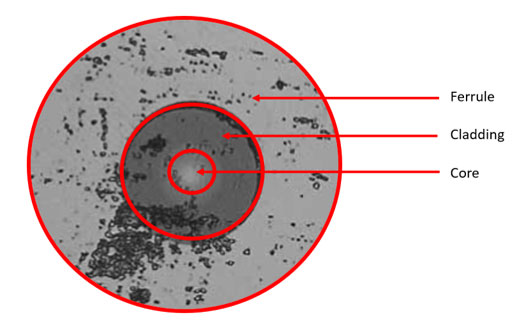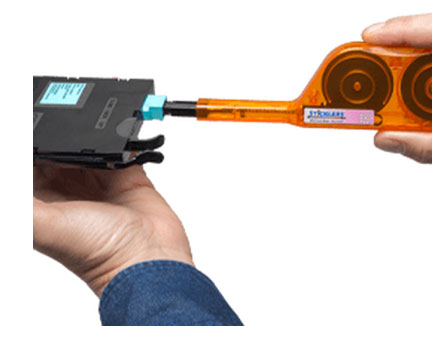Fiber End-Face Contamination: #1 Cause of Failures
- Sep 7th 2021
- By

There is no doubt that fiber connectivity has improved over the years with advancements like superior insertion loss, better alignment, gender and polarity field changes, shutters, and smaller form factors. But despite these advancements, contaminated fiber end faces remain the #1 cause of performance issues in fiber links.
As the number of devices and amount of data reaches an all-time high, data centers demand faster, low-latency transmission of 100, 200, 400, and even 800 Gigabit speeds. That means more fiber links than ever are being deployed in these environments, and these higher-speed applications have more stringent insertion loss and return loss requirements. Any tiny speck of dust or dirt on a connector end face can cause loss and reflections that can degrade network performance or cause costly downtime—and that dust or dirt can transfer to and damage expensive optical transceivers. That’s why cleaning and inspection are an absolute must wherever a fiber end face is exposed!
How Fiber Optic Contamination Occurs
Any time you touch a fiber end face, you’ve likely contaminated it with grease, oil, and even skin cells that remain on your hands despite any effort. While most technicians are careful to avoid touching fiber end faces, there are plenty of other sources of contamination.
Any dirty, dusty environment creates the potential for debris particles to land on a fiber end face. While most data centers are fairly clean, and many have policies in place that prohibit the use of cardboard and packing materials within the white or gray space, there is always the chance for contamination from the surrounding environment. Even clothing that contains body oil, lint, or other substances can be a source of contamination.
Contamination can also easily migrate from one fiber end face to another. In other words, any time you mate a dirty connector to equipment or an adapter, you risk the chance of spreading contamination to the connecting end face. There are some manufacturers that will tout connectors that do not need to be cleaned and inspected, but even the most stringent manufacturing and packaging processes cannot guarantee that connectors fresh out of the bag will be clean. In fact, even the plastic material of a dust cap can contain residue that can migrate to a fiber end face.
How to Inspect Fiber Optic End Faces for Contamination

Inspecting all fiber end faces with a fiber inspection scope is recommended before cleaning and any time you need to troubleshoot fiber links that are not functioning or not performing as expected. During this process, you want to be diligent in inspecting the end face for any dirt, specks, oil, liquid residue, or other contamination.
There are simple handheld inspection scopes available that can handle a range of fiber connector types. Intelligent inspection scopes will automatically detect contamination per IEC standards for cleanliness based on the number, size, and location of particles. Contamination in the core and cladding area of the end face is especially of concern as they can prevent the transmission of light signals and cause significant loss and reflections, but the ferrule area should also be clean as dirt can easily migrate to the core.
Fiber End Face Cleaning

Once you’ve inspected a fiber end face, any contamination needs to be removed. There are two ways to clean—wet cleaning using a solvent or dry cleaning without. Regardless of the type of cleaning, it’s important to use cleaning fluids and wipes specifically designed for fiber connectivity. Isopropyl alcohol and other over-the-counter solvents can leave behind residue that is difficult to remove and wipes not designed for fiber connectivity can leave behind lint or create static that attracts dust.
When cleaning fiber ports or connectors placed in an adapter, faceplate, or bulkhead, it’s also important to use a cleaner designed for the specific fiber interface. For example, if you’re cleaning a multifiber MTP/MPO connector, you want to use an MTP/MPO cleaning tool specifically designed to clean these connections. Whether cleaning a traditional 1.25mm LC Connector and 2.5mm ST & SC Connectors, or one of the newer higher density connectors such as; Senko CS connectors, or USConec MDC connectors, it’s important to use a cleaner that meets your needs. There are even cleaners for cleaning harsh-environment connectors.
Most cleaners are rated for cleaning a maximum number of connectors, so be sure to also select one for the job at hand or make sure you have enough cleaners to get you through. And if you’re dealing with multiple connector types, consider a fiber optic cleaning kit that comes with a variety of cleaners, wipes, and solvents. Refillable cassette cleaners are particularly handy if you do a lot of cleaning.
When cleaning, make sure to apply enough pressure so that the wipe conforms to the fiber end face, but avoid too much pressure or cleaning against a hard surface that could damage the end face. After you clean, the end face should be reinspected with a fiber inspection scope to ensure it’s clean—and if you still see debris, make sure to clean and inspect again.
Remember, keeping your fiber connectors clean will help you avoid performance issues and potential costly downtime!
The good news is that no matter what type of fiber optic connections you need to inspect and clean, CablesPlus USA has the inspection tools and cleaners to meet your needs. And if you’re not sure which type of tool is right for your network, we’re always ready to help.
